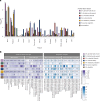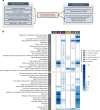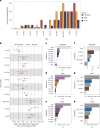Uncovering the multivariate genetic architecture of frailty with genomic structural equation modeling
- PMID: 40759756
- PMCID: PMC12626885
- DOI: 10.1038/s41588-025-02269-0
Uncovering the multivariate genetic architecture of frailty with genomic structural equation modeling
Abstract
Frailty is a multifaceted clinical state associated with accelerated aging and adverse health outcomes. Informed etiological models of frailty hold promise for producing widespread health improvements across the aging population. Frailty is currently measured using aggregate scores, which obscure etiological pathways that are only relevant to subcomponents of frailty. Here we perform a multivariate genome-wide association study of the latent genetic architecture between 30 frailty deficits, which identifies 408 genomic risk loci. Our model includes a general factor of genetic overlap across all deficits, plus six new factors indexing a shared genetic signal across specific groups of deficits. We demonstrate the added clinical and etiological value of the six factors, including predicting frailty in external datasets, highlighting divergent genetic correlations with clinically relevant outcomes and uncovering unique underlying biology linked to aging. We show that nuanced models of frailty are key to understanding its causes and how it relates to worse health.
© 2025. The Author(s), under exclusive licence to Springer Nature America, Inc.
Conflict of interest statement
Competing interests: Although not directly related to the submitted work, K.R. has asserted copyright over the Clinical Frailty Scale and (with O. Theou) the Pictorial Fit-Frail Scale, which have been made freely available for noncommercial education and research, and nonprofit healthcare via completion of a permission agreement stipulating that users will not change, charge for or commercialize the scales. For-profit entities (including pharma) pay a licensing fee, 15% of which is retained by the Dalhousie University Office of Commercialization and Industry Engagement. After taxes, the remainder of the license fees are donated to the Dalhousie Medical Research Foundation. In the past 3 years, licenses have been negotiated with Renibus Therapeutics, Cook Research Incorporated, W.L. Gore Associates, Pfizer, Cellcolabs AB, AstraZeneca UK, Qu Biologics, Biotest AG, BioAge Labs, Congenica and Icosavax. The other authors declare no competing interests.
Figures






References
-
- Kojima, G., Iliffe, S. & Walters, K. Frailty index as a predictor of mortality: a systematic review and meta-analysis. Age Ageing47, 193–200 (2018). - PubMed
-
- O’Caoimh, R. et al. Prevalence of frailty in 62 countries across the world: a systematic review and meta-analysis of population-level studies. Age Ageing50, 96–104 (2021). - PubMed
-
- Young, A. C. M., Glaser, K., Spector, T. D. & Steves, C. J. The identification of hereditary and environmental determinants of frailty in a cohort of UK twins. Twin Res. Hum. Genet.19, 600–609 (2016). - PubMed
MeSH terms
Grants and funding
- R01AG073593/U.S. Department of Health & Human Services | NIH | National Institute on Aging (U.S. National Institute on Aging)
- RF1AG073593/U.S. Department of Health & Human Services | NIH | National Institute on Aging (U.S. National Institute on Aging)
- R01MH120219/U.S. Department of Health & Human Services | NIH | National Institute of Mental Health (NIMH)
- 221890/Z/20/Z/Wellcome Trust (Wellcome)
LinkOut - more resources
Full Text Sources
Medical

